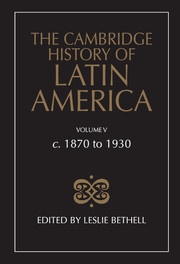Book contents
- Frontmatter
- PART ONE MEXICO
- 1 Mexico: Restored Republic and Porfiriato, 1867–1910
- 2 The Mexican Revolution, 1910–1920
- 3 Mexico: revolution and reconstruction in the 1920s
- PART TWO CENTRAL AMERICA AND THE CARIBBEAN
- PART THREE THE RIVER PLATE REPUBLICS
- PART FOUR THE ANDEAN REPUBLICSo
- PART FIVE BRAZIL
- Bibliographical essays
- References
2 - The Mexican Revolution, 1910–1920
from PART ONE - MEXICO
Published online by Cambridge University Press: 28 March 2008
- Frontmatter
- PART ONE MEXICO
- 1 Mexico: Restored Republic and Porfiriato, 1867–1910
- 2 The Mexican Revolution, 1910–1920
- 3 Mexico: revolution and reconstruction in the 1920s
- PART TWO CENTRAL AMERICA AND THE CARIBBEAN
- PART THREE THE RIVER PLATE REPUBLICS
- PART FOUR THE ANDEAN REPUBLICSo
- PART FIVE BRAZIL
- Bibliographical essays
- References
Summary
Three theoretical assumptions in liberal sociology long ruled historical study of the Mexican Revolution: mass action is consensual, intentional, and redistributive; collective violence measures structural transformation; and nationalism aggregates interests in a limited division of labour. In plain words, movement of ‘the people’ is movement by ‘the people’ for ‘the people’; the bloodier the struggle, the deeper the difference between ways of life before and after the struggle; and familiarity breeds solidarity. The most influential scholars of the subject also made two radical suppositions about Mexico in particular. First, the most significant fact in the country in 1910 was the struggle between the upper and lower classes. Second, the conflict was about to explode. And on these premises respectable research and analysis framed a pro-revolutionary story of the rise of the downtrodden: the Revolution began over a political issue, the succession to Porfirio Díaz, but masses of people in all regions quickly involved themselves in a struggle beyond politics for sweeping economic and social reforms. Enormous material destruction throughout the country, the ruination of business, and total defiance of the United States were necessary for the popular struggle to triumph, as it did. And through the struggle the champions of ‘the people’ became the revolutionary leaders. Economic and social conditions improved in accordance with revolutionary policies, so that the new society took shape within a framework of official revolutionary institutions. The struggle ended in 1917, the year of the revolutionary constitution. The new revolutionary state enjoyed as much legitimacy and strength as its spokesmen said it did.
- Type
- Chapter
- Information
- The Cambridge History of Latin America , pp. 79 - 154Publisher: Cambridge University PressPrint publication year: 1986
References
- 20
- Cited by



